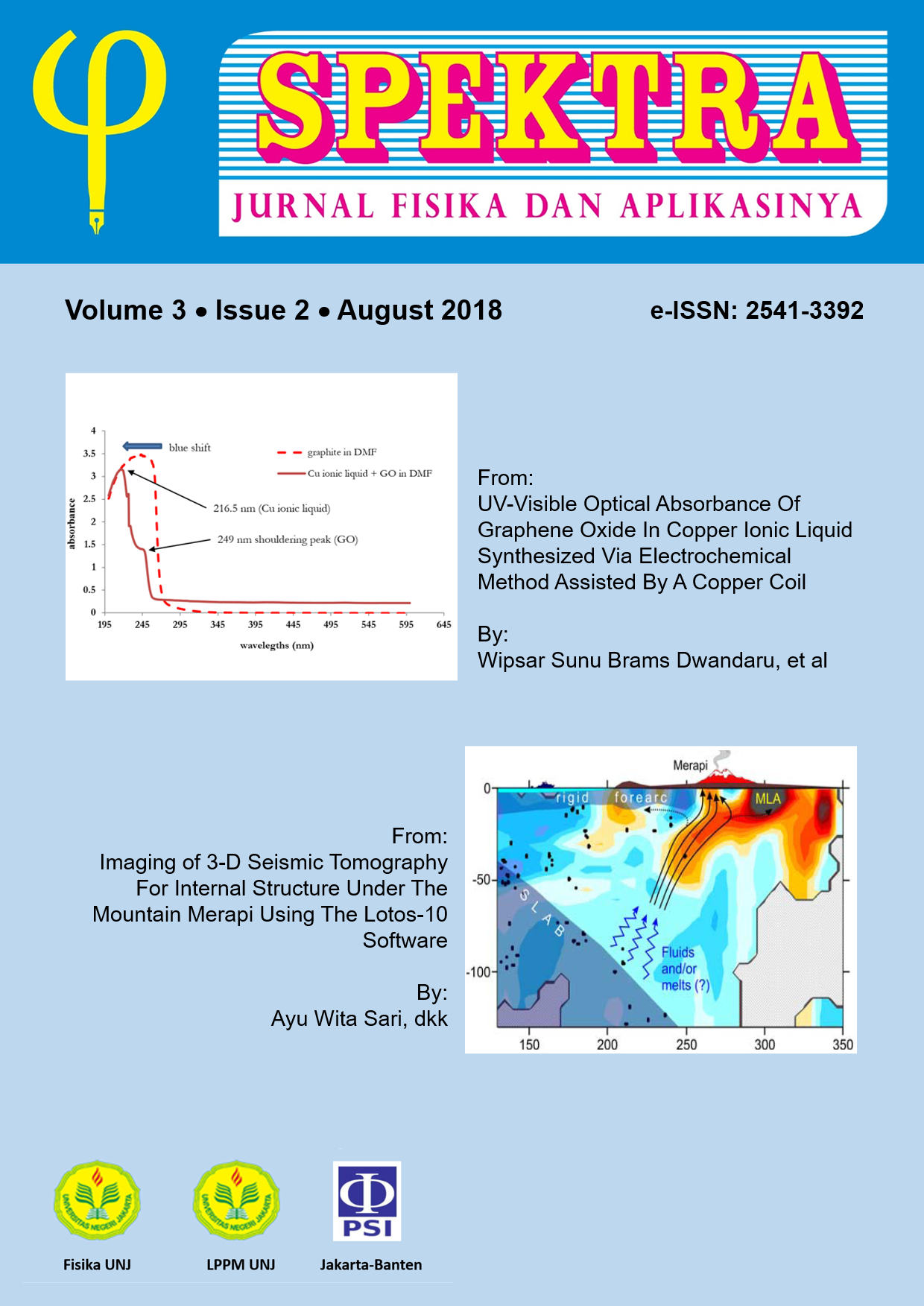TWO STATIC FLUID DARK MATTER MODEL WITH ADDITIONAL COSMOLOGICAL CONSTANT
DOI:
https://doi.org/10.21009/SPEKTRA.032.07Keywords:
konstanta kosmologi, anisotropik, potensial efektif, kecepatan tangensial, cosmological constant, anisotropic, effective potential, tangential velocityAbstract
Abstrak
Pada persamaan medan gravitasi Einstein terdapat konstanta kosmologi sebagai konstanta alam yang menjelaskan model mengembangnya alam semesta dan yang paling dominan terdapat di jagad raya ini adalah dalam bentuk energi gelap (dark energy). Kami meninjau model objek dua fluida tidak terkopel, seperti layaknya materi gelap (dark matter) atau bintang yang memiliki karakteristik tensor energi-momentum dan kecepatan-4 nya yang berbeda serta bersifat anisotropik, kemudian disatukan sebagai model dua fluida untuk ditinjau persamaan TOV (Tolman-Oppenheimer-Volkoff) dan persamaan geodesiknya dalam menunjukkan sifat gerak dan model dua fluida tersebut. Hasil perhitungan menunjukkan bahwa model ini dapat menjelaskan persamaan potensial efektif dengan tambahan konstanta kosmologi sebagai karakteristik gerak dan kecepatan tangensial partikel uji dalam orbit lingkaran stabil.
Kata-kata kunci: konstanta kosmologi, anisotropik, potensial efektif, kecepatan tangensial.
Abstract
In Einstein's gravitational field equation has been found the cosmological constant as the natural constant that describes the universe's expansion model and the most dominant in the universe is the dark energy form. We review the two objects of fluid models are not coupled, like dark matter or stars which has the different characteristic energy-momentum tensor and four velocities and anisotropic tend, then combined as two-fluid models for TOV (Tolman-Oppenheimer-Volkoff) equation and the geodesic equation to characterize the movement and the two fluid models. The calculation result shows that this model can explain the potential equation with an addition of an effective cosmological constant as the movement characteristic and tangential velocity of a tested particle in a stable circular orbit.
Keywords: cosmological constant, anisotropic, effective potential, tangential velocity.
References
[2] H. Heintzmann and W. Hillebrandt, “Neutron Stars with an Anisotropic Equation of State: Mass, Redshift, and Stability,†Astron & Astrophys, vol. 38, pp. 51-55, 1975.
[3] S. Weinberg, “Gravitation and Cosmology: Principles and Applications of the General Theory of Relativity,†Cambridge University, John Wiley & Sons, Inc, 1971.
[4] S. M. Carroll, “An Introduction to General Relativity: Spacetime and Geometry,†Addison Wesley, University of Chicago, 2003.
[5] P. S. Letelier, Phys. Rev. D., vol. 22, pp. 807, 1980; P. S. Letelierand P. S. C. Alencar, Phys. Rev. D., vol. 34, pp 343, 1986.
[6] L. Herrera and N. O. Santos, Physics Reports, vol. 286, no. 53, 1997.
[7] F. Kamiab and N. Afshordi, “Neutron Stars and the Cosmological Constant Problem,†Phys. Rev. D., vol. 84, 2011.
[8] S. M. Carroll, “The Cosmological Constant,†LivingRev. Rel., vol. 4, no. 1, 2001.
Downloads
Published
How to Cite
Issue
Section
License
SPEKTRA: Jurnal Fisika dan Aplikasinya allow the author(s) to hold the copyright without restrictions and allow the author(s) to retain publishing rights without restrictions. SPEKTRA: Jurnal Fisika dan Aplikasinya CC-BY or an equivalent license as the optimal license for the publication, distribution, use, and reuse of scholarly work. In developing strategy and setting priorities, SPEKTRA: Jurnal Fisika dan Aplikasinya recognize that free access is better than priced access, libre access is better than free access, and libre under CC-BY or the equivalent is better than libre under more restrictive open licenses. We should achieve what we can when we can. We should not delay achieving free in order to achieve libre, and we should not stop with free when we can achieve libre.
 SPEKTRA: Jurnal Fisika dan Aplikasinya is licensed under a Creative Commons Attribution 4.0 International License.
SPEKTRA: Jurnal Fisika dan Aplikasinya is licensed under a Creative Commons Attribution 4.0 International License.
You are free to:
Share - copy and redistribute the material in any medium or format
Adapt - remix, transform, and build upon the material for any purpose, even commercially.
The licensor cannot revoke these freedoms as long as you follow the license terms.

 E-ISSN 2541-3392
E-ISSN 2541-3392  Focus & Scope
Focus & Scope  Editorial Team
Editorial Team  Reviewer Team
Reviewer Team  Author Guidelines
Author Guidelines  Article Template
Article Template  Author Fee
Author Fee  Publication Ethics
Publication Ethics  Plagiarism Policy
Plagiarism Policy  Open Access Policy
Open Access Policy  Peer Review Process
Peer Review Process  Retraction & Correction
Retraction & Correction  Licensing & Copyright
Licensing & Copyright  Archiving & Repository
Archiving & Repository  Contact
Contact  Mendeley
Mendeley 

